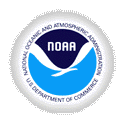 |
U.S. Dept. of Commerce / NOAA / OAR / ERL / PMEL / OERD
1997-98 El Nino Sea Level |
Monthly Mean Sea level for U.S. West Coast, Alaska, Hawaii
U.S. WEST COAST |
ALASKA |
HAWAII |
ALEUTIANS |
 |
U.S. Dept. of Commerce / NOAA / OAR / ERL / PMEL / OERD
1997-98 El Nino Sea Level |
U.S. WEST COAST |
ALASKA |
HAWAII |
ALEUTIANS |
The 1997-98 El Nino has caused higher water levels along the U.S. West Coast and parts of Alaska. It followed the pattern of many previous El Ninos, with high seasonal sea level during the winter in these regions but not in Hawaii. In April-May it returned to normal, or slightly below normal, levels. To track seasonal sea level, we show plots of monthly mean sea level (MMSL) observed at selected NOAA tide gauges along the West Coast, as well as Alaska and Hawaii. To provide a perspective on these observations, the plots also include the average and maximum MMSL that were observed at the same tide stations during the previous 22 years, 1975-96. This period includes the major 1982-83 El Nino. In the plots, the zero-line is the average sea level for 1975-96. The 30-cm interval for sea level height corresponds closely to one foot, since 1 ft = 30.48 cm.
Research on sea level in the North Pacific shows that El Ninos affect MMSL in two ways. The first is via a layer of warm water, lying off the coast, that elevates the coastal water level. Such layers tend to be very persistent off the West Coast because the ocean currents there are relatively weak and the thermal anomalies often penetrate well down into the water column. This thermal rise in coastal water levels dominates Southern California and Hawaii. The second effect is the response to El Nino weather patterns, especially atmospheric pressure and winds. In particular, high sea level is the response to seasonally low atmospheric pressure and prevailing northward winds along the coast. The weather response dominates from central California to southern Alaska and is strongest during late fall and winter. In the plots, please note the similarity across large sections of the coast, indicating the broad-scale nature of the seasonal sea level response to El Nino.
The water levels are measured by NOAA tide gauges. These data are available on-line from the NOS/Oceanographic and Services Division and the University of Hawaii Sea Level Center. There is a delay of 2-4 weeks after a given month has ended before the verified data appear on-line. Unverified data are used for the latest month shown in the plots and are subject to important disclaimers that are stated by the NOS/Oceanographic and Services Division. Information on El Nino for the West Coast of Canada is provided by the Ocean Science and Productivity Division El Nino Watch.
The actual water level that occurs at a coastal site is the sum of seasonal sea level, the astronomical tides and the shorter-period responses to weather forcing, especially winter storms. While the seasonal sea level variations are very broad-scale, there can be substantial regional variations in the tides and storm surges. Such regional variations occur in San Francisco Bay and Puget Sound. In terms of potential coastal flooding, the periods of special concern are when high-range spring tides coincide with high seasonal sea level and frequent storms. For the present El Nino, these are the spring-tide periods of January, February, and March 1998. Forecasts of coastal flooding are provided by NOAA's National Weather Service.
Given below are some useful references to the scientific literature that include citations of research on seasonal and short-period variations in sea level:
Chelton, D.B., and R.E. Davis, Monthly mean sea-level variations along the north coast of North America, Journal of Physical Oceanography, 12, 757-784, 1982.
Emery, W.J., and K. Hamilton, Atmospheric forcing of interannual variability in the northeast Pacific Ocean: connection with El Nino, Journal of Geophysical Research, 857-868, 1985.
Mofjeld, H.O., Subtidal sea level fluctuations in a large fjord system, Journal of Geophysical Research, 97, 20,191-20,199, 1992.
Percival, D.B., and H.O. Mofjeld, Analysis of subtidal coastal sea level fluctuations using wavelets, Journal of the American Statistical Association, 92, 868-880, 1997.
| Contact: H.O.Mofjeld | Web: J. Newman |